J. & W. Grunow Microscope
after 1865, before 1875; ?c. 1874
SERIAL NUMBER: 585
SIGNED ON THE SIDE OF THE OPTICAL TUBE: 'J & W Grunow, NEW YORK, 585'
MODEL: ???
Please Click On Any Picture for a Larger Version
DESCRIPTION:

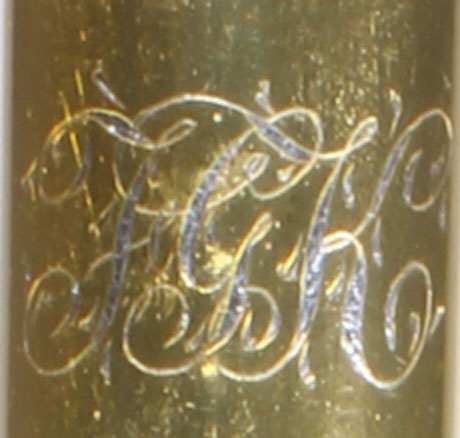 It is signed in Script on the right side of the tube:
It is signed in Script on the right side of the tube: J. & W. Grunow, NEW YORK, 585'
. There is also a fancy monogram on the front of the tube which appears to represent the letters F G K, likely the owners initials.
This is a fairly well-built, Lister-limb microscope incorporating several features that became trademarks of the
Grunow Brothers, as they frequently incorporated these features into their stands. One of the most obvious is the fine
focus control that protrudes outside of the back of the limb.
The Microscope is finished in black, laquered brass, and nickel-plated brass. There are two slightly forward curving uprights arising from the 'V' shaped foot. The Lister limb curves back from the trunions to meet the brass main tube support. Brass retaining nuts adjust the tension on the inclination joint.
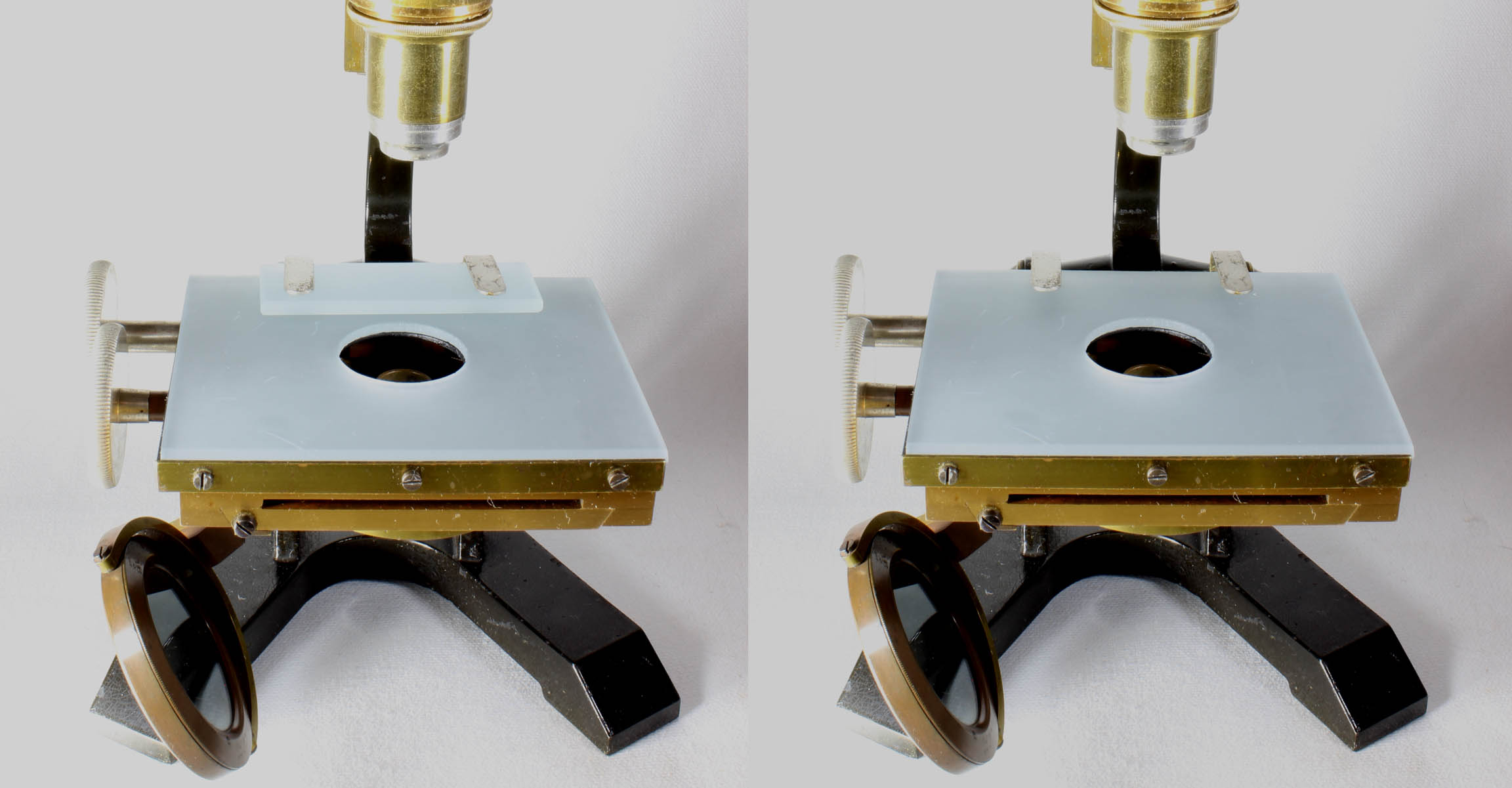 The stage has a frosted glass plate which slips from the left side into grooves on the stage clips in back, and a brass ledge screwed into the front of the stage.
The stage clips are one of the unusual features in that they are not intended to hold a slide but rather other pieces of apparatus. Shown here is a thick frosted glass support which a slide would rest in front of; this small thick piece could be removed and be replaced, for example, by a live box or trough.
The stage has a frosted glass plate which slips from the left side into grooves on the stage clips in back, and a brass ledge screwed into the front of the stage.
The stage clips are one of the unusual features in that they are not intended to hold a slide but rather other pieces of apparatus. Shown here is a thick frosted glass support which a slide would rest in front of; this small thick piece could be removed and be replaced, for example, by a live box or trough.
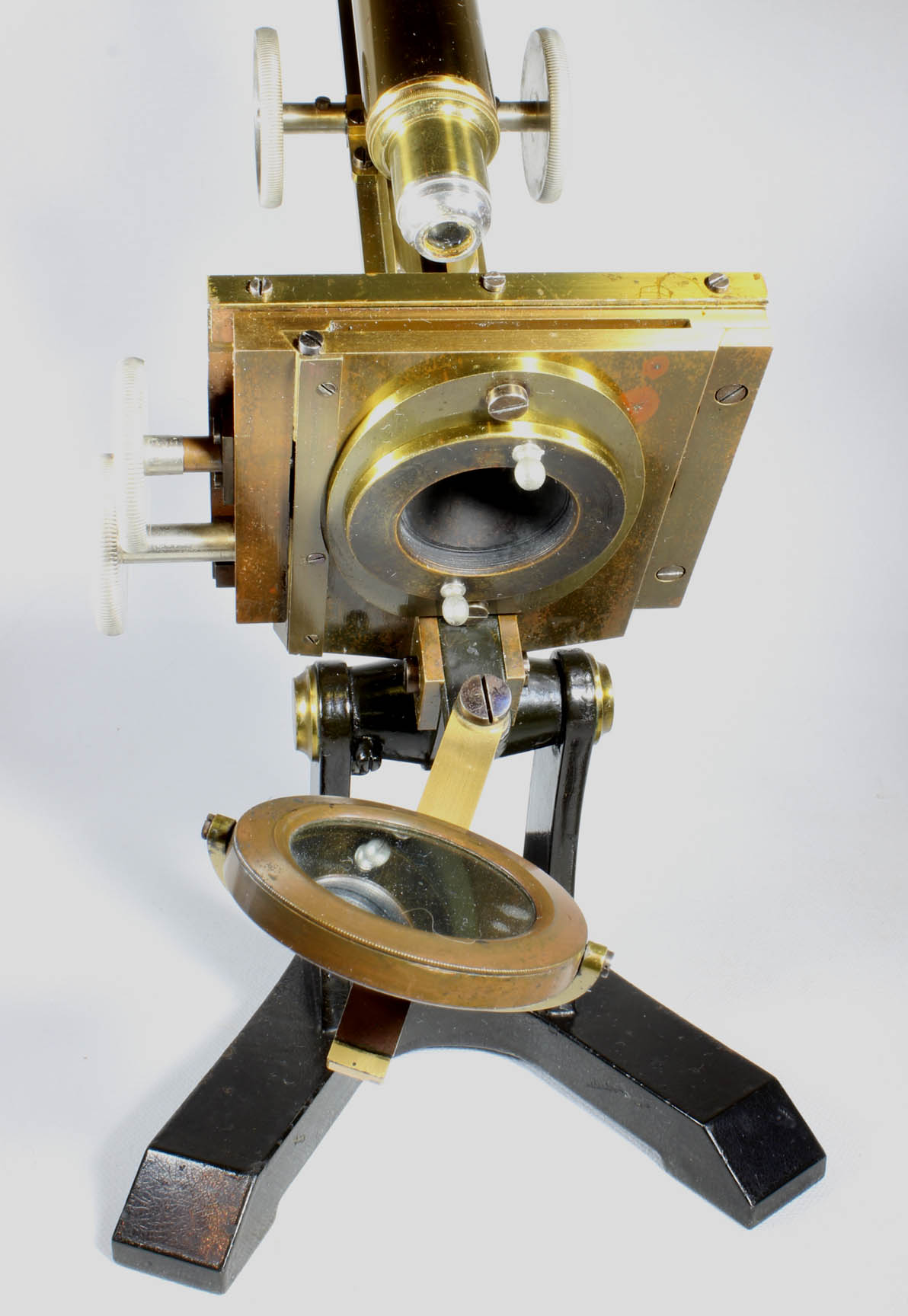
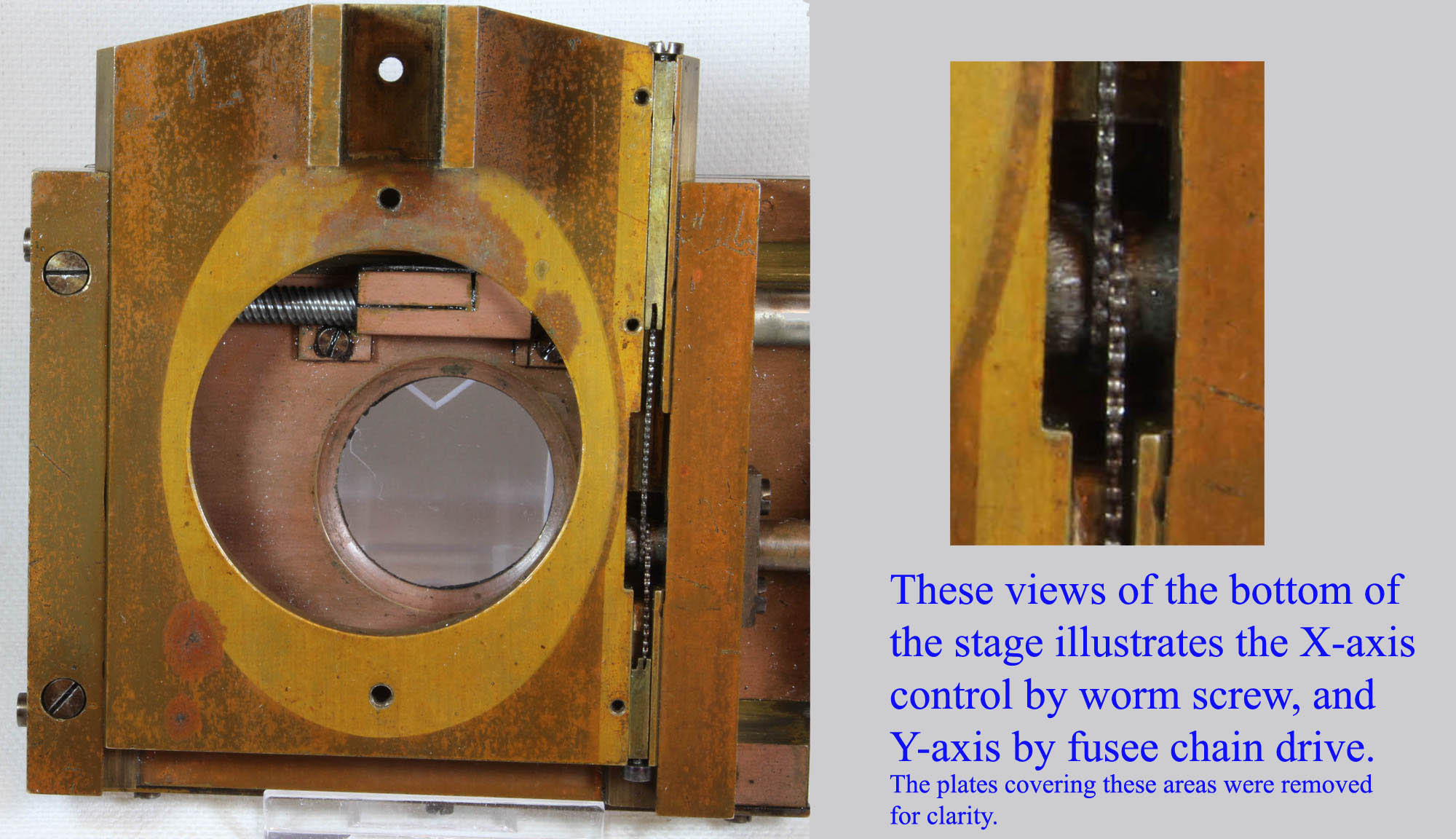 The stage is screwed into the limb as a saddle fitting with a screw from each side. The mechanical stage controls are nickel plated brass. Control of the stage is unusual in that the X-direction is controlled by worm screw, and the Y-direction by fusee chain drive. Under the stage, attached by a bayonet fitting, is a support for one of the three included central stops. This bayonet fitting could be removed to allow more oblique lighting, taking advantage of the swinging tailpiece attached to the front edge of the bottom of the limb. The mirror is a typical Grunow type with one side carrying a (smaller diameter) flat mirror, while the other side carries a larger concave mirror. This feature, is similar to the type found on many Chevalier microscopes made in France.
The stage is screwed into the limb as a saddle fitting with a screw from each side. The mechanical stage controls are nickel plated brass. Control of the stage is unusual in that the X-direction is controlled by worm screw, and the Y-direction by fusee chain drive. Under the stage, attached by a bayonet fitting, is a support for one of the three included central stops. This bayonet fitting could be removed to allow more oblique lighting, taking advantage of the swinging tailpiece attached to the front edge of the bottom of the limb. The mirror is a typical Grunow type with one side carrying a (smaller diameter) flat mirror, while the other side carries a larger concave mirror. This feature, is similar to the type found on many Chevalier microscopes made in France.
Course focus is by straight rack and pinion controlled by Nickel plated knurled knobs. The fine focus is by long lever, acting on the support for the optical tube and is partly exposed, controlled by finely threaded nickel plated knob which screws through the unusual extension of the upper limb, a feature found only on Grunow microscopes. There is no draw tube.
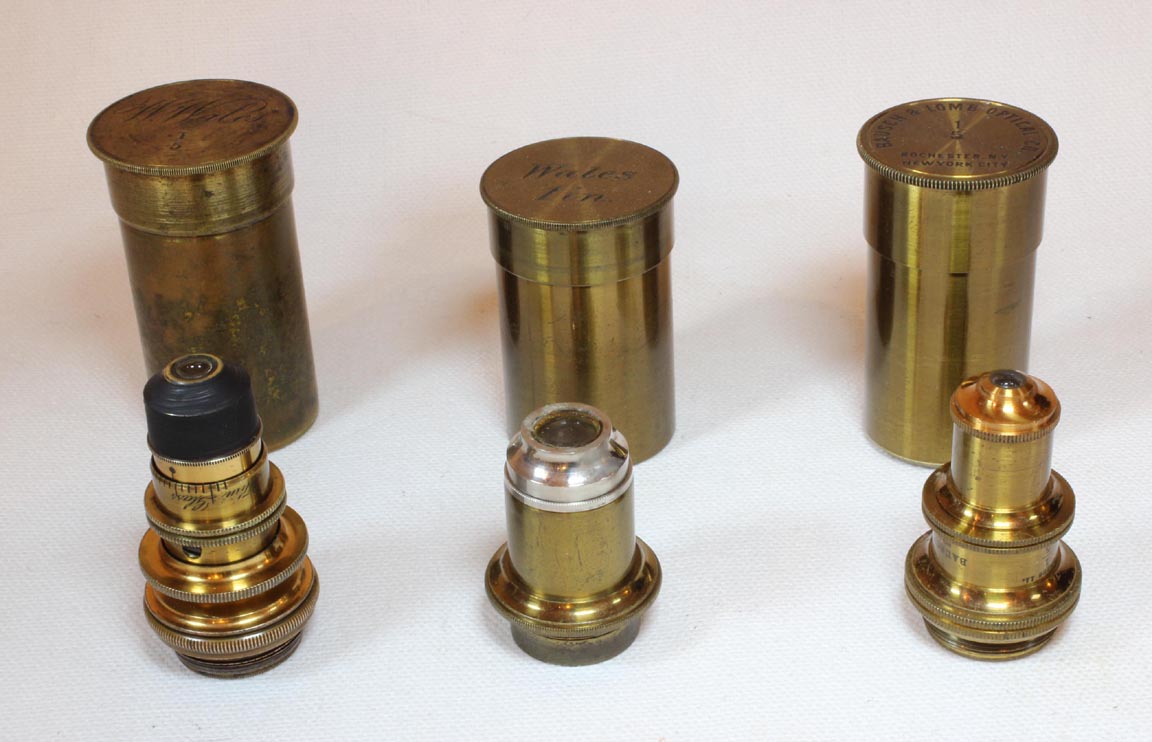
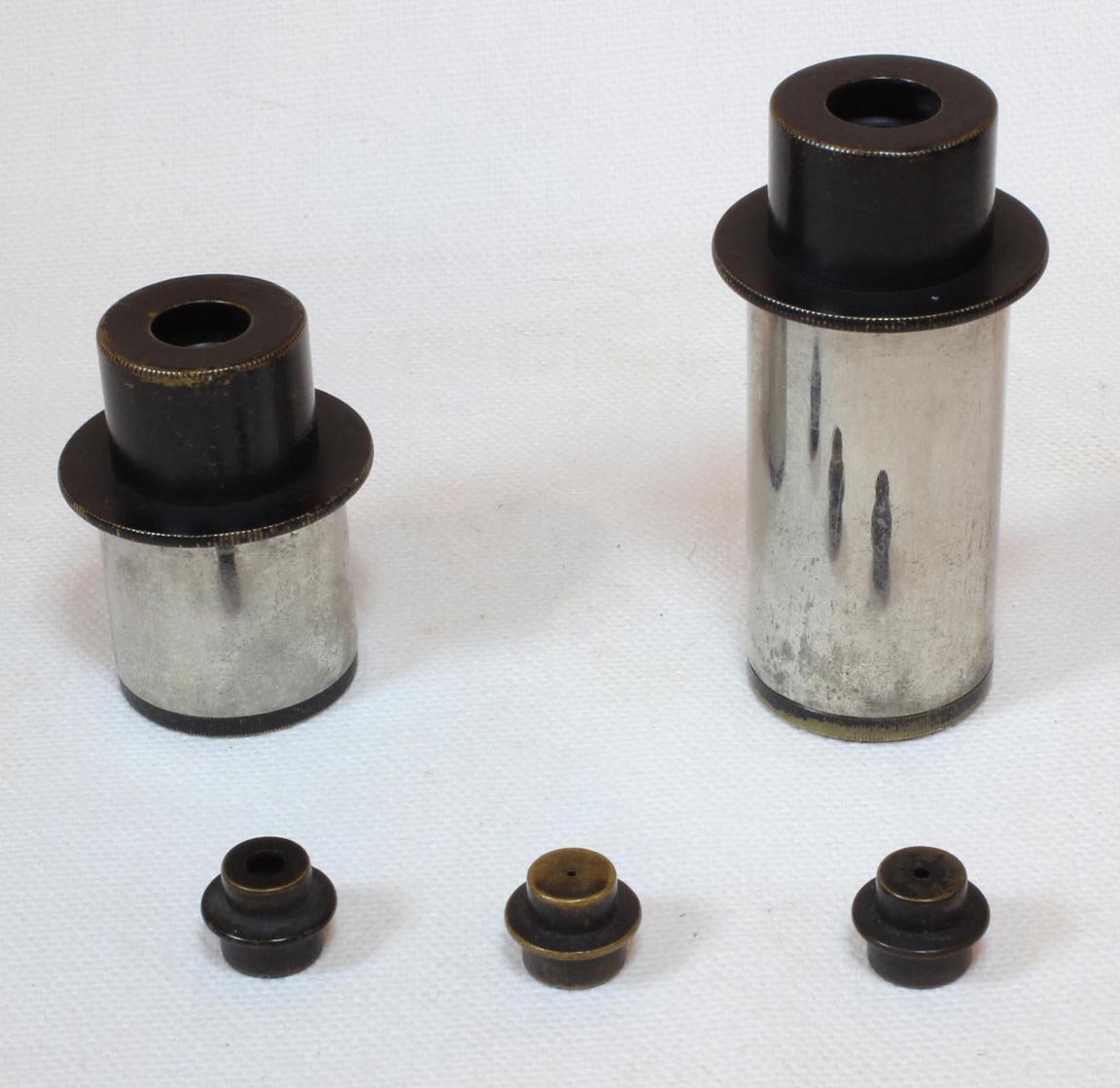 Accessories include the original hardwood case with compartments for objectives on one side and other accessories on the other. The accessory compartment has three holes to accept the three central stops. The two Eyepieces, also nickel plated on the barrels but black on top, are the typical Grunow design. The three objectives with the microscope, all with their original cans, are a 1 inch by Wales, a 1/2 inch by Bausch and Lomb, and a 1/5 inch by Wales with a calibrated correction collar. In addition the black base for a bench condenser is with the instrument and screws to the left side of the inside of the case; the rest of the bench condenser is missing.
Accessories include the original hardwood case with compartments for objectives on one side and other accessories on the other. The accessory compartment has three holes to accept the three central stops. The two Eyepieces, also nickel plated on the barrels but black on top, are the typical Grunow design. The three objectives with the microscope, all with their original cans, are a 1 inch by Wales, a 1/2 inch by Bausch and Lomb, and a 1/5 inch by Wales with a calibrated correction collar. In addition the black base for a bench condenser is with the instrument and screws to the left side of the inside of the case; the rest of the bench condenser is missing.
HISTORY OF THE GRUNOW MICROSCOPES
J. Grunow was already a 'mechanic' (machinist in modern jargon), when he emigrated from Berlin in 1849.
He settled in New Haven, Connecticut and constructed his first microscopes for Drs Gilman and Van Arsdale in 1852.
Around that year, his brother W. Grunow also came to America and joined him.
Microscopists of the day apparently
went to the Grunows for microscope construction, and the first practical binocular, invented by Ridell of the University of
Louisiana was constructed by them. They were also apparently the first to make Dr Lawrence J Smith's invention of an
inverted chemical microscope. Examples of both of these are in the Billings collection, including the original versions of
both the Smith inverted microscope, and the Riddell binocular. The latter was donated directly by Mrs Ridell to the Billings
collection. The Grunows were also among the first to incorportate a disc of apertures directly into the top of the stage,
although in this model, individual aperture stops were supplied.
One of the unique features of Grunows was the practice of casting a protruding ledge as part of the limb to house the fine adjustment knob. The location of this lever adjustment varied. It can found lower on the limb on simpler models where it controlled the stage (see the East Caroline U collection example here), or as in the smaller and later Grunow in this collection seen on this webpage, on the top of limb to act on the focusing block. Another example of that location
can be seen on a spectacular lacquered brass binocular model at Alan Wisner's Website
here.
Grunow also used the nosepiece short lever fine adjustment on some of their early stands as shown on another example at Alan Wisner's site,
and later for cheaper stands, they also used a tilting stage fine adjustment, tilting the stage from the side as in
this example on this website. The latter should not be confused with the control of the stage from the rear, which is a much more refined
and precise mechanism
engaging the stage which rides up and down a dovetailed fitting; in the later andcheaper stand,
the mechanism simply tilts the stage sideways.
Known serial numbers range from 56, for Smith's chemical microscope, said to be made in 1855, to over 1000.
Grunow's Production was relatively limited over the years and it has been said they only made about 1000 stands
through their entire 40 year business, making their stands much less common than, for instance, Bausch & Lomb.
Grunows moved to New York City sometime between 1861 and 1864. J. Grunow took over the business of microscope production in about 1874.
Known serial numbers range from 56, for Smith's chemical microscope, said to be made in 1855,
to over 1000, so this model is about in the middle of production numbers.
Grunow's Production was relatively limited over the years and it has been said they only made about 1000 stands
through their entire 40 year business, making their stands much less common than, for instance, Bausch & Lomb.
Grunows moved to New York City in 1864 or so. The J & W. Signature was used until 1874, but after that
W. Grunow left the microscope part of the business and it was simply named 'J. Grunow.' The business ended about 1892. I would therefore approximate this
instrument to about 1874, based on serial number, signature, and similar dated Grunow microscopes.
I would appreciate any further information on dating this microscope.
To see an image of a later (incomplete) example of a smaller and less sophisticated Grunow see
here.

 It is signed in Script on the right side of the tube:
It is signed in Script on the right side of the tube:  The stage has a frosted glass plate which slips from the left side into grooves on the stage clips in back, and a brass ledge screwed into the front of the stage.
The stage clips are one of the unusual features in that they are not intended to hold a slide but rather other pieces of apparatus. Shown here is a thick frosted glass support which a slide would rest in front of; this small thick piece could be removed and be replaced, for example, by a live box or trough.
The stage has a frosted glass plate which slips from the left side into grooves on the stage clips in back, and a brass ledge screwed into the front of the stage.
The stage clips are one of the unusual features in that they are not intended to hold a slide but rather other pieces of apparatus. Shown here is a thick frosted glass support which a slide would rest in front of; this small thick piece could be removed and be replaced, for example, by a live box or trough. 
 The stage is screwed into the limb as a saddle fitting with a screw from each side. The mechanical stage controls are nickel plated brass. Control of the stage is unusual in that the X-direction is controlled by worm screw, and the Y-direction by fusee chain drive. Under the stage, attached by a bayonet fitting, is a support for one of the three included central stops. This bayonet fitting could be removed to allow more oblique lighting, taking advantage of the swinging tailpiece attached to the front edge of the bottom of the limb. The mirror is a typical Grunow type with one side carrying a (smaller diameter) flat mirror, while the other side carries a larger concave mirror. This feature, is similar to the type found on many Chevalier microscopes made in France.
The stage is screwed into the limb as a saddle fitting with a screw from each side. The mechanical stage controls are nickel plated brass. Control of the stage is unusual in that the X-direction is controlled by worm screw, and the Y-direction by fusee chain drive. Under the stage, attached by a bayonet fitting, is a support for one of the three included central stops. This bayonet fitting could be removed to allow more oblique lighting, taking advantage of the swinging tailpiece attached to the front edge of the bottom of the limb. The mirror is a typical Grunow type with one side carrying a (smaller diameter) flat mirror, while the other side carries a larger concave mirror. This feature, is similar to the type found on many Chevalier microscopes made in France.

 Accessories include the original hardwood case with compartments for objectives on one side and other accessories on the other. The accessory compartment has three holes to accept the three central stops. The two Eyepieces, also nickel plated on the barrels but black on top, are the typical Grunow design. The three objectives with the microscope, all with their original cans, are a 1 inch by Wales, a 1/2 inch by Bausch and Lomb, and a 1/5 inch by Wales with a calibrated correction collar. In addition the black base for a bench condenser is with the instrument and screws to the left side of the inside of the case; the rest of the bench condenser is missing.
Accessories include the original hardwood case with compartments for objectives on one side and other accessories on the other. The accessory compartment has three holes to accept the three central stops. The two Eyepieces, also nickel plated on the barrels but black on top, are the typical Grunow design. The three objectives with the microscope, all with their original cans, are a 1 inch by Wales, a 1/2 inch by Bausch and Lomb, and a 1/5 inch by Wales with a calibrated correction collar. In addition the black base for a bench condenser is with the instrument and screws to the left side of the inside of the case; the rest of the bench condenser is missing.